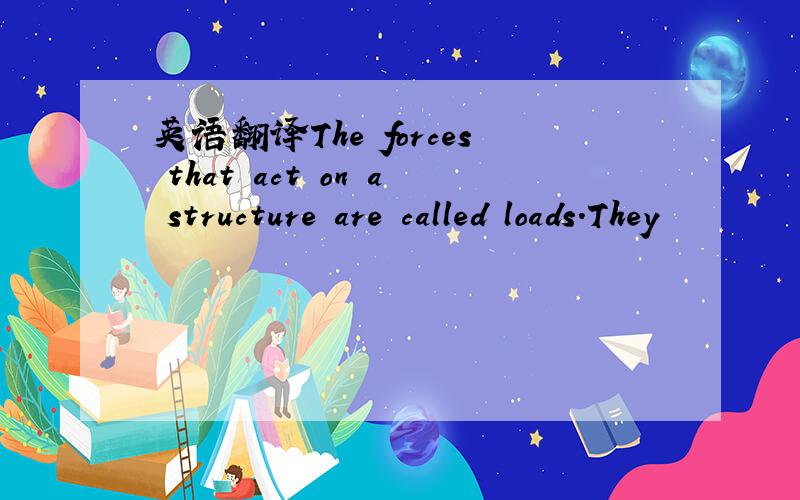英语翻译The forces that act on a structure are called loads.They
来源:学生作业帮 编辑:神马作文网作业帮 分类:英语作业 时间:2024/11/17 07:59:12
英语翻译
The forces that act on a structure are called loads.They belong to one of two bread categories:dead load and live load.Dead loads are those that are permanent,including the weight of the structure itself,which is sometimes called the self-weight.In addition to the weight of the structure,dead loads in a building include the weight of nonstructural components such as floor coverings,partitions,and suspended ceilings (with light fixtures,mechanical equipment,and plumbing.) All of the loads mentioned thus far are forces resulting from gravity and are referred to as gravity loads.Live loads,which can also be gravity loads,are those that are not as permanent as dead loads.They may or may not be acting on the structure at any given time,and the location may not be fixed.Examples of live loads include furniture,equipment,and occupants of buildings.In general,the magnitude of a live load is not as well defined as that of a dead load,and it usually must be estimated.In many cases,a structural member must be investigated for various positions of a live load so that a potential failure condition is not overlooked.
If a live load is applied slowly and is not removed and is reapplied an excessive number of times,the structure can be analyzed as if the load were static.If the load is applied suddenly,as would be the case when the structure supports a moving crane,the effects of impact must be accounted for.If the load is applied and removed many times over the life of the structure,fatigue stress becomes a problem,and its effects must be accounted for.Impact loading occurs in relatively few buildings,notably industrial buildings,and fatigue loading is rare,with thousands of load cycles over the life of the structure required before fatigue becomes a problem.For these reasons,all loading conditions in this book will be treated as static,and fatigue will not be considered.
The forces that act on a structure are called loads.They belong to one of two bread categories:dead load and live load.Dead loads are those that are permanent,including the weight of the structure itself,which is sometimes called the self-weight.In addition to the weight of the structure,dead loads in a building include the weight of nonstructural components such as floor coverings,partitions,and suspended ceilings (with light fixtures,mechanical equipment,and plumbing.) All of the loads mentioned thus far are forces resulting from gravity and are referred to as gravity loads.Live loads,which can also be gravity loads,are those that are not as permanent as dead loads.They may or may not be acting on the structure at any given time,and the location may not be fixed.Examples of live loads include furniture,equipment,and occupants of buildings.In general,the magnitude of a live load is not as well defined as that of a dead load,and it usually must be estimated.In many cases,a structural member must be investigated for various positions of a live load so that a potential failure condition is not overlooked.
If a live load is applied slowly and is not removed and is reapplied an excessive number of times,the structure can be analyzed as if the load were static.If the load is applied suddenly,as would be the case when the structure supports a moving crane,the effects of impact must be accounted for.If the load is applied and removed many times over the life of the structure,fatigue stress becomes a problem,and its effects must be accounted for.Impact loading occurs in relatively few buildings,notably industrial buildings,and fatigue loading is rare,with thousands of load cycles over the life of the structure required before fatigue becomes a problem.For these reasons,all loading conditions in this book will be treated as static,and fatigue will not be considered.

dead load 固定负载
live load, 活荷载;活载重,活负载
地面装饰及地毯floor coverings
Partitions 隔墙系统
light fixtures灯具
厕、浴间设备plumbing fixtures
moving crane行走中的吊车
作用于一个建筑结构的力叫做“负载”.他们属于两个相对应的类别之一:固定负载和活负载.固定负载是那些恒定不变的负载,包括有时称为“自重”的建筑结构自身的重量.除了建筑结构的重量外,建筑物中的固定负载包括非建筑结构成分例如地毯、隔墙系统和吊顶(带有灯具,机械设备和厕、浴间设备.)的重量.因为所有提到的这些负载均因重力引起,故指的是“重力负载”.活负载(也可以是重力负载)不象固定负载那样恒定.它们可能在任何给定的时间作用于或离开建筑结构,而且活负载的位置也是不固定的.活负载的例子包括家具、设备和建筑居住者.一般来讲,活负载的大小通常不象固定负载那样有详细说明,它通常必须估计.多数情况下,必须研究构件不同作用位置的活负载以便于潜在的破坏条件不被忽视.
如果活负载被缓慢加载并且不被移走,以及频繁地重复加载,建筑结构的(受力情况)分析时可以把负载看作静态的.如果负载是突然加载的,例如该建筑结构支撑了一个行走的吊车的情况,就必须考虑到“冲击”的效应了.如果负载在建筑结构的整个寿命中多次加载和去除,疲劳应力成为一个问题,这种效应也必须计算在内.冲击性加载发生在相对较少的建筑物中,较明显的是工业性建筑,而(此类建筑中)疲劳性加载则很少见,建筑结构的整个寿命中有成千上万次的加载循环才需要考虑疲劳问题.因为这些原因,本书中所有负载条件用静态负载处理,而不考虑疲劳问题.
live load, 活荷载;活载重,活负载
地面装饰及地毯floor coverings
Partitions 隔墙系统
light fixtures灯具
厕、浴间设备plumbing fixtures
moving crane行走中的吊车
作用于一个建筑结构的力叫做“负载”.他们属于两个相对应的类别之一:固定负载和活负载.固定负载是那些恒定不变的负载,包括有时称为“自重”的建筑结构自身的重量.除了建筑结构的重量外,建筑物中的固定负载包括非建筑结构成分例如地毯、隔墙系统和吊顶(带有灯具,机械设备和厕、浴间设备.)的重量.因为所有提到的这些负载均因重力引起,故指的是“重力负载”.活负载(也可以是重力负载)不象固定负载那样恒定.它们可能在任何给定的时间作用于或离开建筑结构,而且活负载的位置也是不固定的.活负载的例子包括家具、设备和建筑居住者.一般来讲,活负载的大小通常不象固定负载那样有详细说明,它通常必须估计.多数情况下,必须研究构件不同作用位置的活负载以便于潜在的破坏条件不被忽视.
如果活负载被缓慢加载并且不被移走,以及频繁地重复加载,建筑结构的(受力情况)分析时可以把负载看作静态的.如果负载是突然加载的,例如该建筑结构支撑了一个行走的吊车的情况,就必须考虑到“冲击”的效应了.如果负载在建筑结构的整个寿命中多次加载和去除,疲劳应力成为一个问题,这种效应也必须计算在内.冲击性加载发生在相对较少的建筑物中,较明显的是工业性建筑,而(此类建筑中)疲劳性加载则很少见,建筑结构的整个寿命中有成千上万次的加载循环才需要考虑疲劳问题.因为这些原因,本书中所有负载条件用静态负载处理,而不考虑疲劳问题.
英语翻译The forces that act on a structure are called loads.They
How many forces act on a basketball placed on the surface of
英语翻译6ResultsStudy of the cross structure design wave loads f
they put on (a;an;the;\)one-act play
英语翻译Dead loads are defined as fixed,nonmovable loads of a pe
they ____manatee A are called B called
英语翻译identify forces that act as stimulants to change and con
英语翻译The market structure that exists that there are many sma
英语翻译I always find that they are snotty,and always act like t
英语翻译全句是Measures of the initiation of structure that are free
英语翻译26.Magnetic Forces Imagine that a current-carrying wire
Match the sentences that are in the same structure.